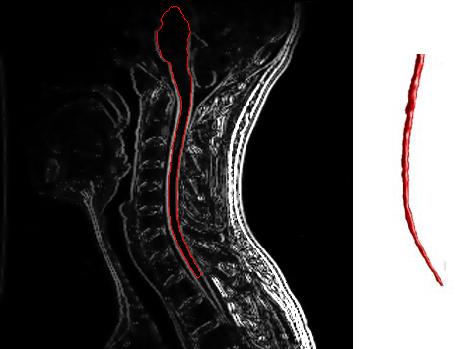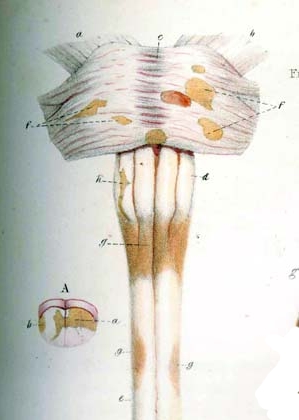 MRI image of ther spinal cord from a patient with Multiple Sclerosis. The extent of the lesions can be seen in the MRI reconstruction of this patient's spinal cord. Right: Carswell's 1838 image of the lesions in the brainstem and spinal cord of a patient with MS |
 |
Multiple sclerosis (MS) is an inflammatory disease in which the myelin sheaths around axons are damaged. While the cause is not clear, the underlying mechanism is thought to be either destruction of CNS myelin by the inmmune system (autoimmunity), or a failure of production of myelin. The long-term outcome is not easily predictable. Good outcomes are more common in females, in people who develop the disorder in their youth, and those with a relapsing course particularly if they have only had a few attacks. One hypothesis is that the blood brain barrier is breached because of infection, such as a viral infection. The entry of T-lymphocytes, activated by the virus, into the CNS is thought to cause an autoimmune attack on oligodendrocytes, resulting in a loss of myelin. Remyelination starts but is incomplete, and repeated immune attacks cause relapses, that worsen the demyelination process. Scars, sclerosis occurs in the white matter because of astrocytic hypertrophy. These scars are often adjacent to the ventricular system, ventricles or central canal of the spinal cord. Clinical Physiological Investigations Evoked potential techniques have proved useful in screening for demyelination because of the sloing in axonal conduction associated with the loss of oligodendrocytes. One example is the use of the Visual Evoked Potential that shows slowing of conduction in patients with optic neuritis: these patients may have temporary loss or blurring of vision, double vision, or a lack of coordination between the two eyes. | Signs and Symptoms commonly include: Visual problems including temporary loss or blurring of vision, double vision, or a lack of coordination between the two eyes. Vision may vary depending on the time of day or the circumstances - for example, it might get worse when you are stressed, tired or in unfamiliar surroundings. Balance problems and dizziness: Symptoms might mean patients are wobbly on their feet from time to time, or might need to move with more care than before to avoid losing balance. Stiffness or Spasms: affect at least 20 per cent of people with MS at some time. Like all MS symptoms, spasms and stiffness affect people differently and can vary over time. Speech difficulties of some kind affect between 40 and 50 per cent of people with MS. Not everyone is aware that MS can cause this problem, and can make assumptions about why their speech is affected. More details of the pathways involved can be found in the specific sections on motor control in Chapters 4 and 5. Fatigue in MS is not just an ordinary tiredness, as is experienced at the end of a hard day's work. It's as an overwhelming sense of tiredness that often occurs after very little activity. |
